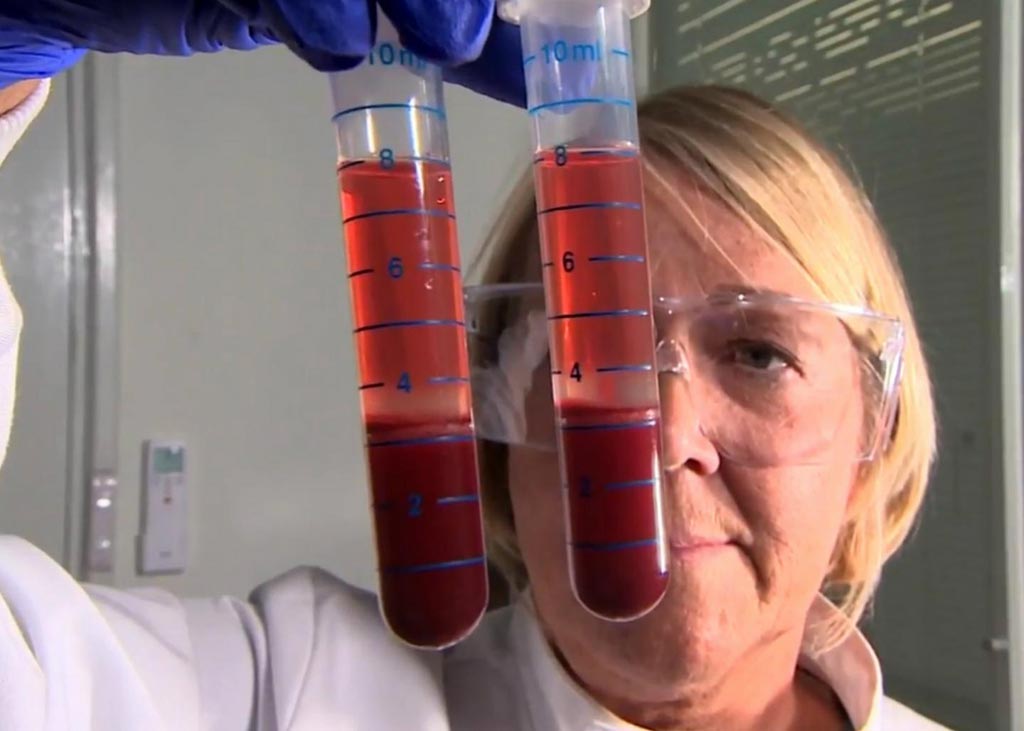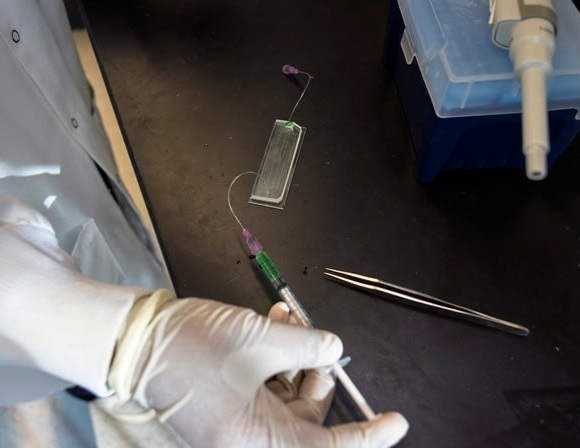Bacteriophage-Based Blood Test Rapidly Detects TB Bacteria
|
By LabMedica International staff writers Posted on 15 Jul 2019 |

Image: A researcher preparing blood samples for Actiphage testing (Photo courtesy of the University of Nottingham, School of Bioscience).
A blood test based on bacteriophage that infect living Mycobacterium tuberculosis (Mtb) bacteria has been shown to diagnose human tuberculosis (TB) and may be able to predict which patients with latent tuberculosis will progress to the active form of the disease.
It is difficult to diagnosis tuberculosis through traditional culture of the slow growing Mtb. Molecular tests to detect Mtb DNA are of limited value due to the organisms’ cell wall, which complicates DNA extraction. The new PBD Biotech (Suffolk, United Kingdom) Actiphage test uses a specific bacteriophage that infects live Mtb and ruptures the cells to release DNA. The DNA is then analyzed by PCR. The whole testing process can be completed in as little six hours.
Investigators at Leicester Biomedical Research Centre (United Kingdom) and the University of Nottingham (United Kingdom) used the Actiphage test to study 66 subjects who were separated into four groups: those with active pulmonary TB, those with latent TB, a control group of patients referred for suspected TB but found not to have the disease, and a control group of healthy individuals. The subjects were tested for Mtb twice, 12 months apart.
Results of Actiphage testing revealed positive findings for 73% of subjects who were subsequently diagnosed with TB. None of the participants in the control groups tested positive with Actiphage, and none of the patients with latent TB who tested negative with Actiphage went on to develop active TB.
The finding that two of the three subjects with latent TB infection who tested positive with Actiphage went on to develop the active form of the disease more than six months later, suggested that the test may have a predictive role in identifying people with the infection at risk of developing the disease.
“TB is the leading cause of death from an infectious disease. It most commonly affects the lungs and from this site is transmitted to others by coughing and sneezing. As there is a lack of diagnostic tools for people unable to bring up sputum, diagnosis is delayed, increasing the likelihood that the disease is spread,” said senior author Dr. Pranabashis Haldar, clinical senior lecturer at the University of Leicester. “Our observations provide new insights into how human TB develops and support recent evidence of the existence of a transitional state of TB infection called incipient TB that does not produce symptoms but carries a high risk of progressing to active TB. There is potential for Actiphage to be developed, both as a mainstream blood test to diagnose TB and as a test used in screening programs to help us identify and treat people with latent infection.”
The study was published in the June 22, 2019, online edition of the journal Clinical Infectious Diseases.
Related Links:
PBD Biotech
Leicester Biomedical Research Centre
University of Nottingham
It is difficult to diagnosis tuberculosis through traditional culture of the slow growing Mtb. Molecular tests to detect Mtb DNA are of limited value due to the organisms’ cell wall, which complicates DNA extraction. The new PBD Biotech (Suffolk, United Kingdom) Actiphage test uses a specific bacteriophage that infects live Mtb and ruptures the cells to release DNA. The DNA is then analyzed by PCR. The whole testing process can be completed in as little six hours.
Investigators at Leicester Biomedical Research Centre (United Kingdom) and the University of Nottingham (United Kingdom) used the Actiphage test to study 66 subjects who were separated into four groups: those with active pulmonary TB, those with latent TB, a control group of patients referred for suspected TB but found not to have the disease, and a control group of healthy individuals. The subjects were tested for Mtb twice, 12 months apart.
Results of Actiphage testing revealed positive findings for 73% of subjects who were subsequently diagnosed with TB. None of the participants in the control groups tested positive with Actiphage, and none of the patients with latent TB who tested negative with Actiphage went on to develop active TB.
The finding that two of the three subjects with latent TB infection who tested positive with Actiphage went on to develop the active form of the disease more than six months later, suggested that the test may have a predictive role in identifying people with the infection at risk of developing the disease.
“TB is the leading cause of death from an infectious disease. It most commonly affects the lungs and from this site is transmitted to others by coughing and sneezing. As there is a lack of diagnostic tools for people unable to bring up sputum, diagnosis is delayed, increasing the likelihood that the disease is spread,” said senior author Dr. Pranabashis Haldar, clinical senior lecturer at the University of Leicester. “Our observations provide new insights into how human TB develops and support recent evidence of the existence of a transitional state of TB infection called incipient TB that does not produce symptoms but carries a high risk of progressing to active TB. There is potential for Actiphage to be developed, both as a mainstream blood test to diagnose TB and as a test used in screening programs to help us identify and treat people with latent infection.”
The study was published in the June 22, 2019, online edition of the journal Clinical Infectious Diseases.
Related Links:
PBD Biotech
Leicester Biomedical Research Centre
University of Nottingham
Latest BioResearch News
- Genome Analysis Predicts Likelihood of Neurodisability in Oxygen-Deprived Newborns
- Gene Panel Predicts Disease Progession for Patients with B-cell Lymphoma
- New Method Simplifies Preparation of Tumor Genomic DNA Libraries
- New Tool Developed for Diagnosis of Chronic HBV Infection
- Panel of Genetic Loci Accurately Predicts Risk of Developing Gout
- Disrupted TGFB Signaling Linked to Increased Cancer-Related Bacteria
- Gene Fusion Protein Proposed as Prostate Cancer Biomarker
- NIV Test to Diagnose and Monitor Vascular Complications in Diabetes
- Semen Exosome MicroRNA Proves Biomarker for Prostate Cancer
- Genetic Loci Link Plasma Lipid Levels to CVD Risk
- Newly Identified Gene Network Aids in Early Diagnosis of Autism Spectrum Disorder
- Link Confirmed between Living in Poverty and Developing Diseases
- Genomic Study Identifies Kidney Disease Loci in Type I Diabetes Patients
- Liquid Biopsy More Effective for Analyzing Tumor Drug Resistance Mutations
- New Liquid Biopsy Assay Reveals Host-Pathogen Interactions
- Method Developed for Enriching Trophoblast Population in Samples
Channels
Clinical Chemistry
view channel
Noninvasive Blood-Glucose Monitoring to Replace Finger Pricks for Diabetics
People with diabetes often need to measure their blood glucose multiple times a day, most commonly through finger-prick blood tests or implanted sensors. These methods can be painful, inconvenient, and... Read more
POC Breath Diagnostic System to Detect Pneumonia-Causing Pathogens
Pseudomonas aeruginosa is a major cause of hospital-acquired and ventilator-associated pneumonia, particularly in lung transplant recipients and patients with structural lung disease. Its ability to form... Read moreMolecular Diagnostics
view channel
World's First NGS-Based Diagnostic Platform Fully Automates Sample-To-Result Process Within Single Device
Rapid point-of-need diagnostics are of critical need, especially in the areas of infectious disease and cancer testing and monitoring. Now, a direct-from-specimen platform that performs genomic analysis... Read more
Rapid Diagnostic Breakthrough Simultaneously Detects Resistance and Virulence in Klebsiella Pneumoniae
Antibiotic resistance is a steadily escalating threat to global healthcare, making common infections harder to treat and increasing the risk of severe complications. One of the most concerning pathogens... Read moreHematology
view channel
MRD Tests Could Predict Survival in Leukemia Patients
Acute myeloid leukemia is an aggressive blood cancer that disrupts normal blood cell production and often relapses even after intensive treatment. Clinicians currently lack early, reliable markers to predict... Read more
Platelet Activity Blood Test in Middle Age Could Identify Early Alzheimer’s Risk
Early detection of Alzheimer’s disease remains one of the biggest unmet needs in neurology, particularly because the biological changes underlying the disorder begin decades before memory symptoms appear.... Read more
Microvesicles Measurement Could Detect Vascular Injury in Sickle Cell Disease Patients
Assessing disease severity in sickle cell disease (SCD) remains challenging, especially when trying to predict hemolysis, vascular injury, and risk of complications such as vaso-occlusive crises.... Read more
ADLM’s New Coagulation Testing Guidance to Improve Care for Patients on Blood Thinners
Direct oral anticoagulants (DOACs) are one of the most common types of blood thinners. Patients take them to prevent a host of complications that could arise from blood clotting, including stroke, deep... Read moreImmunology
view channel
Blood Test Could Identify Colon Cancer Patients to Benefit from NSAIDs
Colon cancer remains a major cause of cancer-related illness, with many patients facing relapse even after surgery and chemotherapy. Up to 40% of people with stage III disease experience recurrence, highlighting... Read moreBlood Test Could Detect Adverse Immunotherapy Effects
Immune checkpoint inhibitors have transformed cancer treatment, but they can also trigger serious immune-related adverse events that damage healthy organs and may become life-threatening if not detected early.... Read morePathology
view channel
AI Tool Simultaneously Identifies Genetic Mutations and Disease Type
Interpreting genetic test results remains a major challenge in modern medicine, particularly for rare and complex diseases. While existing tools can indicate whether a genetic mutation is harmful, they... Read more
Rapid Low-Cost Tests Can Prevent Child Deaths from Contaminated Medicinal Syrups
Medicinal syrups contaminated with toxic chemicals have caused the deaths of hundreds of children worldwide, exposing a critical gap in how these products are tested before reaching patients.... Read more
Tumor Signals in Saliva and Blood Enable Non-Invasive Monitoring of Head and Neck Cancer
Head and neck cancers are among the most aggressive malignancies worldwide, with nearly 900,000 new cases diagnosed each year. Monitoring these cancers for recurrence or relapse typically relies on tissue... Read moreTechnology
view channel
Diagnostic Chip Monitors Chemotherapy Effectiveness for Brain Cancer
Glioblastoma is one of the most aggressive and fatal brain cancers, with most patients surviving less than two years after diagnosis. Treatment is particularly challenging because the tumor infiltrates... Read more
Machine Learning Models Diagnose ALS Earlier Through Blood Biomarkers
Amyotrophic lateral sclerosis (ALS) is a rapidly progressive neurodegenerative disease that is notoriously difficult to diagnose in its early stages. Early symptoms often overlap with other neurological... Read moreIndustry
view channel
BD and Penn Institute Collaborate to Advance Immunotherapy through Flow Cytometry
BD (Becton, Dickinson and Company, Franklin Lakes, NJ, USA) has entered into a strategic collaboration with the Institute for Immunology and Immune Health (I3H, Philadelphia, PA, USA) at the University... Read more










 (3) (1).png)











